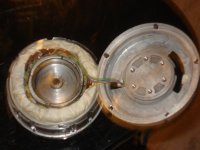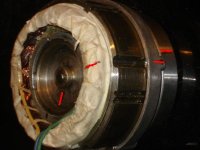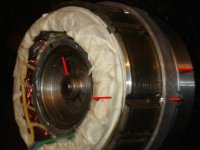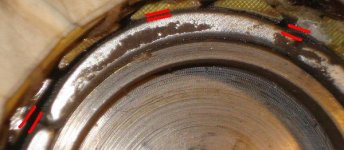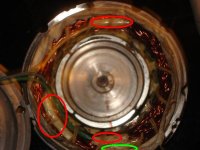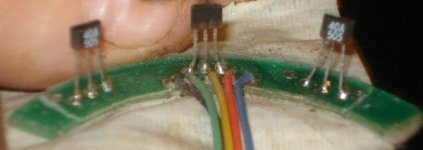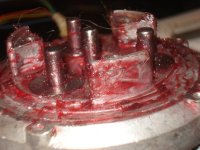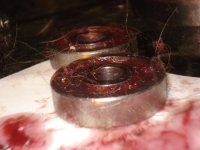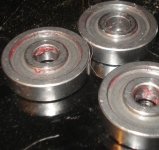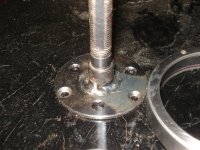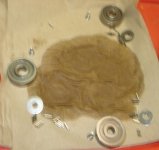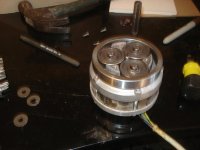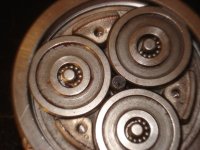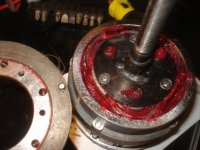The broken Tongxin/Currie geared hub arrived from Drewjet today;
http://www.endless-sphere.com/forums/viewtopic.php?f=9&t=25089&start=0
(quoted after my part of this post so it doesn't vanish after the marketplace thread expires).
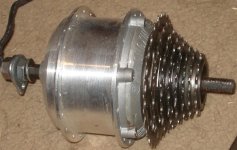
First step was disassembly to see what might be wrong (problem with the planetary and/or halls was reported) and for curiosity, of course.

These don't have a normal planetary gear set, but rather planetary friction rollers, made of steel. Presumably they have an interference fit to start with, and as these wear they become too loose to properly transmit power under typical load, but still work normally under no or lesser loads.
View attachment 5
It is an interesting design, as it makes the motor itself an inrunner, with the stator outside and thus easier to cool compared to the probably more typical outrunner design I've seen on the Fusins, for example. I don't know how it affects torque, given that the magnets/rotor will be a smaller diameter, being inside the stator windings.
The bearings for the planetary rollers are just loose roller (pin) bearings, which don't fit tightly at all within the space between the rollers and the axles they ride on. They would just fall out when the retaining cap is off if it werent' for the thick red grease used liberally everywhere inside the planetary and clutch area.
View attachment 4
The retaining cap has a thin stainless washer covering them to keep them inside. The rollers and bearings appear to be stainless as well, but I'm not sure, as they do respond to magnetic tools. The retaining cap is welded to the drive-side axle stub, which is separate from the leftside axle, that presumably ends at the left outer edge of the motor's stator case the same way.
I'm not sure what effect this discontinous axle has on the total system strength, regarding heavy loads placed on the wheel. For my purposes with this specific motor it's irrelevant, but for a heavy cargo bike using this as a hub motor in a rear wheel, I wonder what problems it might cause, if any.
The one-way clutch appears to be a roller type as well, though I can't open it up to see for sure; I can see the springs that push the rollers or pawls outward, but not the rollers/pawls themselves.
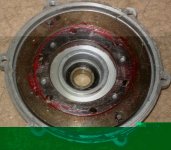
It's outer ring engages to the planetary's "ring gear" ring via just two little pins on the clutch (hard to see in the pics) with holes in the ring.

The inner ring engages the hub casing via six screws from outside.
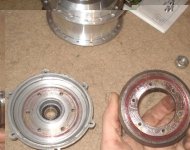
The side cover engages the rest of the hub cover via six more screws, on the drive side like the clutch.
View attachment 2
Freewheel threads are aluminum, part of the side cover itself. Bearing is just about centered within the threaded area, held in with a lip on the inside and a C-clip on the outside. It appears possible for the threads to separate from the rest of the casing if enough torque was applied via chain drive, but no sign of it happening on this motor is visible.
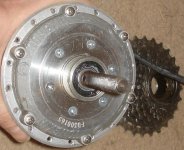
There is just enough of a nub on the left side that it could probably be threaded for a disc-mount for brakes, assuming there'd be clearance for the calipers to the spokes. Being aluminum, it might be possible to thread it without a die, using a steel freewheel core with cuts thru the threads for thread scrap to pass thru during cutting.
Alternately, one could be mounted directly to the cover itself, if it was drilled out in the appropriate pattern and spacers used, but the cover is pretty thin there so I'm not sure how well it would work.
Halls are mounted to a little board on the back of the stator case, with just some paper masking tape covering them (presumably to prevent shorting by any metal bits that might migrate around the hub for whatever reason).
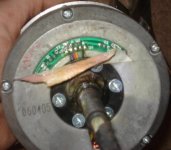
Phase wires appear to be 16G, either PTFE or similar teflon coated. Halls are much smaller, 24G maybe 22G, same type of insulation. Feed thru axle appears standard, as does axle size.
The freewheel cassette that came on the motor is damaged, appears that it's lockring is split right at one of the pinholes for removing it.
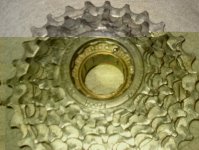
It doesn't freewheel, possibly because the lockring is sticking to something inside or maybe the lockring broke because of whatever failed inside. Haven't tried to open it up to find out; it's a cheapie Chinese type AFAICT, 13T-28T 7speed. I probably have parts to fix it if I find need or use for it, from other junk cassettes.
Testing with the hub opened up and motor held in my hand, leaving just the planetary spinning, the motor appears to work normally, though it sounds kinda rough (cogging?) at low speeds and just noisy at high speeds (due to the planetary I think), with my Lyen 6FET with this combo:
[pre]Motor Controller
Phase
B G
Y Y
G B
Hall
B G
Y B
G Y[/pre]
I didn't go thru the whole 36-combo chart, just stopped at the first combo that worked, as it only draws about 1.5A at full throttle, no load, on 48V (Vpower pack). So there may be other combos that work or work better.
I reassembled the hub so I could stick it in some dropouts and test with a "glove load", using some leather work gloves to grip the hub casing as it spins to load it down and see if I could cause slippage of the planetary. Unfortunately I was interrupted by the dogs at this point, and then hunger, so I will go back to do this part later, as soon as I have time. (I kinda took time I meant to spend on yardwork today to do this already).
Eventually, assuming I can find and fix whatever planetary problem there is, I'd like to try this as a middrive unit in something. It's even smaller than the Fusins, and with the inrunner design should be easier to cool with a little ventilation. Plus since it's a rear hub, I can use it to pass the power from pedals back to the wheel as well as motor power, without back-driving the pedals. If mounted in the rear dropouts of the front frame of a long bike (like CrazyBike2 is, and like it's descendant probably will be here: http://endless-sphere.com/forums/viewtopic.php?f=3&t=16920&start=0 )
then I can even use a rear derailer to shift gears for the pedals to have different gearing than the motor has, depending on conditions/etc.
Then run the chain from the motor itself back to a second regular bike drivetrain, also shiftable, for more optimal use of it's small power.
********************************************
drewjet said:I have 3 Currie hub motors. I believe they are Tongxin, One of them I know for sure, as it is embossed on it. All 3 have issues with the gear reduction. I believe there is a fix for it. Also halls may not be working. I believe they will run sensorless, and I will double check prior to shipping. All you have to pay is for shipping. No Warranty ont these.
PM me or drewjet@cfl.rr.com
View attachment 2011-02-08 16.10.12.jpg
View attachment 2011-02-08 16.10.23.jpg
View attachment 12
View attachment 2011-02-08 16.10.44.jpg


